Perhaps you’ve heard that the United States held an election recently.
As the dust clears and local, state, and federal ballots are counted, Sightline’s team of researchers is using this page to tell you how the results matter to sustainability issues here in the Pacific Northwest.
Seattle bus service was on the ballot; it won. Housing reform in Portland got a mixed result at city council. Montana took a rightward turn, and late returns will show the future of ranked-choice voting in Alaska. And with interest in reforms to our democracy at its highest point in decades, election-reform measures won in Oregon, Colorado, Minnesota, and California while failing in Massachusetts.
Washington
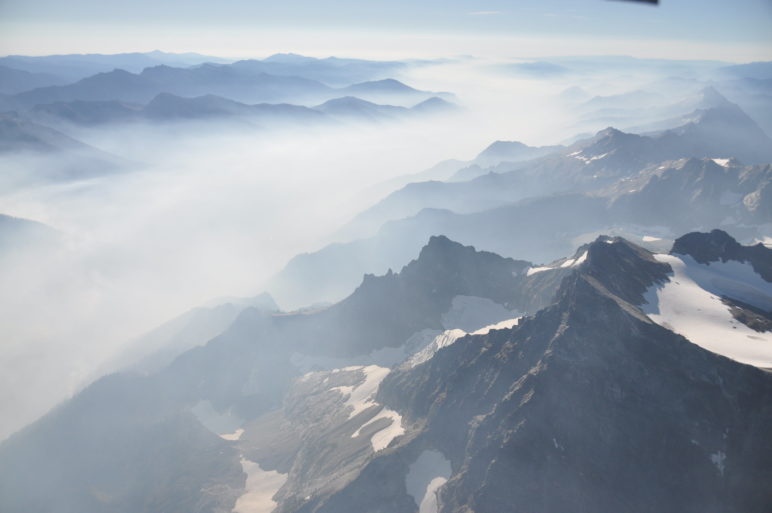
Smoke over the North Cascades. Photo: U.S. Forest Service, public domain.
Before the 2020 elections, Democrats held majorities in Washington’s state House (57 – 41) and Senate (28 – 21). The result of this intense campaign? For the next two years, the split will be exactly the same.
Republicans flipped one seat in the House and one seat in the Senate: In the 19th District (southwest Washington), Jeff Wilson defeated incumbent Democratic Senator Dean Takko and Joel McEntire defeated incumbent Democratic Representative Brian Blake. Democrats also flipped one seat in the House and one seat in the Senate: T’wina Nobles unseated incumbent Republican Senator Steve O’Ban in the 28th (south of Tacoma) and Alicia Rule defeated incumbent Republican Represenatative Luanne Van Werven in the 42nd (Bellingham).
An incredibly close contest in the 5th District left moderate Democrat Mark Mullet of Issaquah ahead of progressive Democrat Ingrid Anderson by just 57 votes. Anderson, endorsed by the newly reelected Governor Jay Inslee, would have been a champion for climate issues like a clean fuel standard, while Sen. Mullet has a mixed record on environmental issues.
In Washington’s Congressional delegation, Republican Representative Jaime Herrera-Beutler defeated Democrat Carolyn Long in Portland’s suburb and much of southwest Washington. East and southeast of Seattle, Democratic Representative Kim Schrier defeated Republican Jesse Jensen. With US Congressman Denny Heck headed back to Olympia as the presumptive lieutenant governor-elect, his 10th District seat was open. Former Tacoma Mayor Marilyn Strickland, a notable housing reform advocate, defeated her fellow Democrat, climate hawk Beth Doglio.
For the city of Seattle proper, Proposition No. 1 passed overwhelmingly. It’ll fund better bus service for Seattle residents through a slight increase in local sales tax. This will further invest in a strategy that has made Seattle one of the few US cities to grow both bus and total transit ridership, pre-pandemic.
Oregon
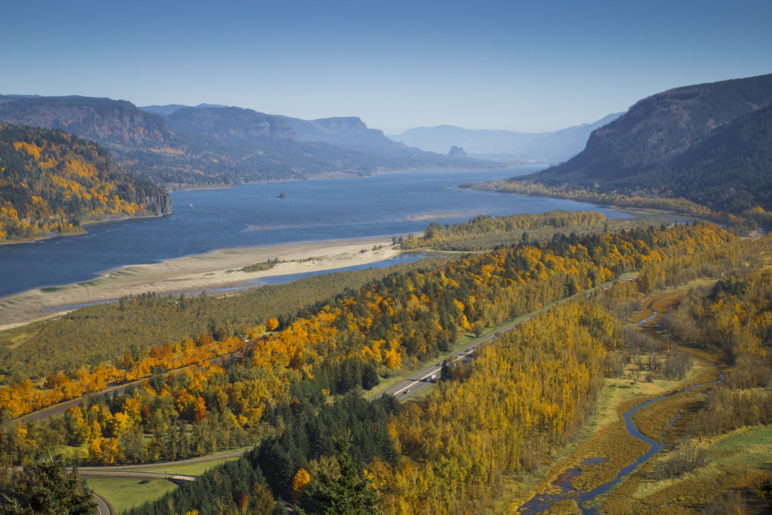
Columbia River Gorge, Oregon. Photo: Bonnie Moreland, Creative Commons.
In Oregon, Democrat Shemia Fagan won her race for secretary of state, which could turn out to have been a shadow race for governor if second-term Governor Kate Brown were to accept a job in a potential Biden administration. Fagan, 39, had toppled a longtime state senator in 2018 in a race that became a referendum on his opposition to rent control. Fagan, whose mother had been homeless during her childhood, helped lead the charge for Oregon’s legalization of both rent control and missing-middle housing in 2019.
The statewide Measure 107 passed with about three-quarters of the vote, allowing state and local governments to cap campaign contributions and require contribution disclosures. This might reduce the ability of polluters and other commercial interests to bigfoot their way through Oregon’s policymaking process.
At the regional level, the transportation Measure 26-218 was trailing even in Multnomah County, the key to its passage. It would have covered the local share of a new light-rail line through southwest Portland and its suburbs and funded various other projects aimed at reducing auto dependence. A consortium of large employers, who (along with medium employers, down to those with 25 payroll employees) would have been charged a payroll tax to fund the projects, spent heavily to defeat it.
As Portland prepares for a big conversation about modernizing its council elections and how to build on recent major housing reforms, incumbent Mayor Ted Wheeler won reelection with a plurality, and newcomer Mingus Mapps looked headed for a larger win against first-term Commissioner Chloe Eudaly. Wheeler had led the charge for the city’s legalization of fourplexes and below-market sixplexes, one of the few high-profile issues where he found much common ground with his main runoff opponent Sarah Iannarone. Write-in candidates including Teressa Raiford, like Iannarone a police reform activist, peeled off about 13 percent of the vote, while Wheeler came in with 46 percent. Wheeler will be Portland’s only mayor elected without a popular majority on the final ballot since at least 1944, and Iannarone’s six-percent loss the closest miss.
In the state legislature, Democrats held barely enough state legislature seats to potentially raise taxes on bad things like carbon pollution or underused urban land: exactly the 18 seats needed in the state Senate, and one seat to spare, 37, in the state House. That puts conservative Democratic Senator Betsy Johnson, who represents the northwest corner of the state, once again in a commanding political position.
Idaho
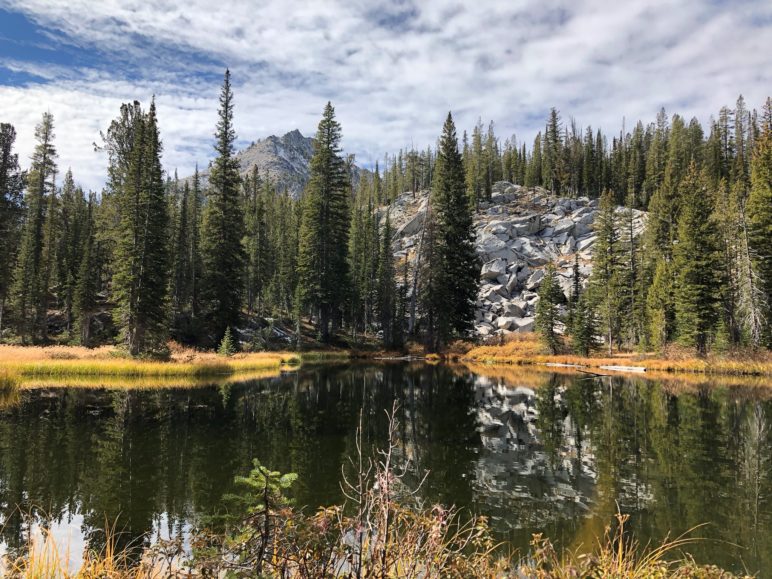
Little Lookout Lake, Idaho. Photo: U.S. Forest Service, public domain.
In Idaho, climate hawks often play defense. The state Senate provides a bulwark against the most egregious attacks on science and environmental protection. In a win for climate, Senator David Nelson of Moscow, Idaho narrowly defeated Dan Foreman, a pugilistic climate change denier who used to hold the seat. Democratic Senate minority leader Michelle Stennett from Ketchum, Idaho handily defeated Eric Parker in a district that’s usually safe for Democrats. Parker gained notoriety for escaping felony charges in the showdown at Cliven Bundy’s ranch and then founding the Idaho chapter of the Three Percenter militia group. Overall, the Democrats did not lose any state senate seats.
Boise is among the top ten fastest growing metro areas in the US. The results of local races for county council and road districts will shape whether future public investments support more compact, affordable housing and alternatives to automobiles. Progressive favorite Diana Lachiondo lost her seat to Ryan Davidson, the former chair of the county Republican party. The result puts a Republican majority back in control of the Ada County Commission and fewer checks on sprawling development patterns. Two winners to the Ada County Highway District favor more investment in sidewalks and bike paths which may tip the balances somewhat in the ongoing fights about how to invest the local transportation dollars.
Trump increased his statewide share of the vote in Idaho from 59% in 2016 to 64% in 2020 and in fast-growing Ada County from 42% to 50%. Boise city proper continues to vote blue but the neighboring suburbs vote red and the recent influx of new residents have, if anything, have trended redder. These election results suggest partisan geographic sorting continues apace which means extreme right politicians like Lt. Governor Janice McGeachin will remain politically viable in Idaho.
Montana
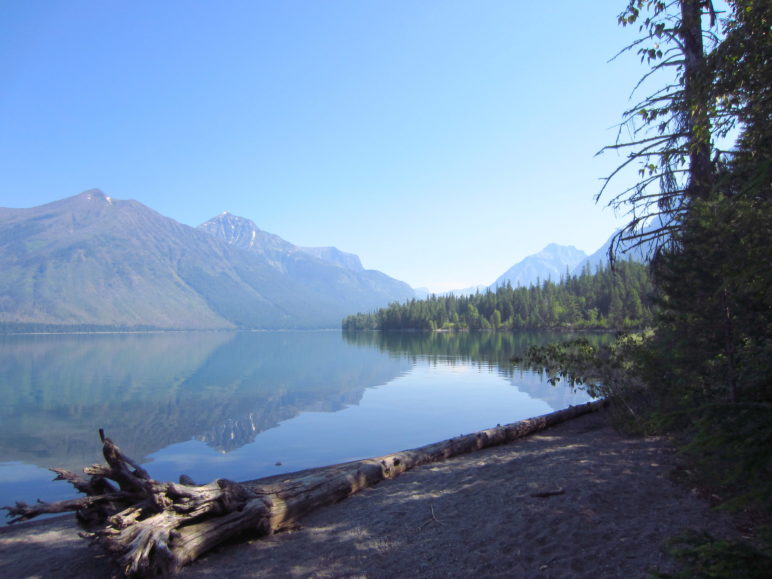
Glacier National Park. Photo: National Park Service, public domain.
In recent years, Montana was the purplest of Cascadian states—the only state of the five Sightline is tracking this year that currently splits its Senators between the two major parties and has a governor of a different party (Democrat) than the state legislature’s majority (Republican). Long a competitive state between the parties, Montana’s politics have shifted along with national trends in the United States: its Democratic base was once white and working class, concentrated in the state’s unionized mining industry. Nowadays, the state’s white working class voters, like those elsewhere, are the base of the Republican party. The state’s white Democrats tend to be more educated and metropolitan, especially in and around Bozeman and Missoula, while the other base of the party is the state’s large indigenous population, both in its cities and on its many tribal lands. Dye the precinct-level map of the state’s 2016 presidential voting red and blue and you can see Montana’s urban and reservation boundaries clearly: blue islands in a sea of red.
But this year, the national trends of polarization and party-line voting caught up with Big Sky Country. Few voters split their tickets, so three statewide races that looked close in pre-election polls, all ended up as lopsided Republican victories.
- Montanans assigned their Electoral College votes to Trump, by 16 points, down from the 20 point margin of 2016.
- US Senator Steve Daines won the main attraction race in the state, beating out popular two-term Democratic Governor Steve Bullock by 10 points. This was Cascadia’s most-watched Senate contest—one that’s dumped $160 million, mostly from outside the state, on Montana’s modest media markets.
- Republican Greg Gianforte, who is the state’s sole US House member, beat Lieutenant Governor Mike Cooney, a veteran Democratic office holder, by 12 points in the governor’s race.
- Republican state auditor Matt Rosendale won the race to fill the seat in the US House that Gianforte vacated to run for governor, beating Democrat Kathleen Williams by 12 points.
- In other statewide races, such as attorney general, Republicans had a clean sweep. .
- Montanans shifted their legislature further right, adding nine state house and one state senate seat to the Republican column. They control two thirds of the house now, along with three-fifths of the senate.
Before the results were tallied, we wrote: “Montana is simultaneously trending in two directions. Its rural areas and emptying eastern quarters are becoming as conservative as Wyoming or Idaho, while its fast-growing metro areas, filling with young, progressive newcomers with college degrees and cosmopolitan outlooks, are pulling it in the direction of coastal Cascadia. Which way will Montana go?” This year’s general election, which set a new high water mark for voter turnout, answered firmly, “Montana will be more like Wyoming and Idaho, with unified conservative control.”
Alaska
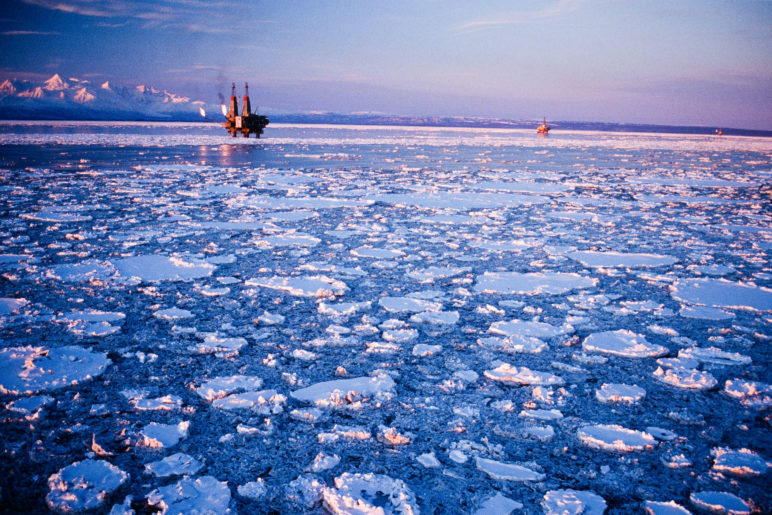
Arctic Alaska. Photo: Bureau of Safety and Environmental Enforcement, public domain.
The big question in reddish Alaska was where on the conservative side of the spectrum the state would fall. No Democrats ran in the national races for US Senate and House. Instead, Republican incumbents faced Independent challengers who would have likely caucused with the Democrats. In the end, the national races went straight Republican, with President Trump, US Sen. Dan Sullivan, and US Rep. Don Young clinching decisive wins.
As a champion of sensible reforms to democracy, we were glad to see Alaska voters approve a ballot measure to reform Alaska’s elections by introducing ranked-choice voting and open primaries. The measure squeaked by with just over 50 percent support. (See more about that in the next section and in this article.) For a while, we weren’t sure where this measure would go since races in Alaska took longer to call than most other states. About 45 percent of registered voters cast absentee ballots, but the state didn’t start counting them until one week after Election Day.
President Trump beat President-Elect Joe Biden by 10 points, 53 to 43 percent. That was no surprise. Biden, however, had the best showing by a Democrat in Alaska since 1964, when President Lyndon Johnson won Alaska. He also beat Trump by about 1 percent in Anchorage, while Trump proved exceedingly popular in the boroughs abutting Alaska’s largest city.
The US Senate race was hotly contested, but when it came down to votes, Senator Dan Sullivan, a Republican, maintained a wide margin over Al Gross, an Independent and medical doctor/commercial fisher endorsed by the Democratic Party. Alaska’s economic dependence on oil tends to keep politicians of all stripes in the pro-development camp. And so it was with Sullivan and Gross. Both called for continued oil drilling and exploration on Alaska’s North Slope, including in the Arctic National Wildlife Refuge. The two differed somewhat in their approaches to fighting climate change, with Sullivan expressing little support for US participation in the Paris Climate Agreement and Gross pledging to fight for the US to rejoin it. Sullivan, a by-the-book Republican who toes the line with President Trump, was endorsed by the Anchorage Daily News.
Representative Don Young, who has served in Congress for longer than any Republican, defeated Alyse Galvin, an Independent who also challenged him in 2018. Galvin supported drilling in the Arctic, including the Arctic National Wildlife Refuge, and was endorsed by the Democratic Party. Neither Galvin nor Young supported the Green New Deal. Both have said Alaska is overly reliant on oil production and support a gradual transition to a more diverse economy and energy mix. Young, however, does not believe that humans are responsible for climate change. Galvin recognizes the role humans play in causing climate change and the fact that Alaska is suffering from its effects.
A ballot measure to tax oil companies more aggressively proved unpopular. The fight took the form of Ballot Measure 1, which would have increased taxes on certain oil and gas fields. The oil industry spent a record $25 million to oppose the measure, with the bulk coming from ConocoPhillips Alaska, BP, and ExxonMobil. No other ballot initiative in Alaska history has attracted as much spending on a single campaign. The companies said it would have throttled exploration and investment in new oil development with a “massive,” tax increase. Supporters of the measure, with a significantly smaller war chest of $1.5 million, said the industry is not paying its fair share of revenue. With slowing oil production causing dire fiscal issues, the question of where to get new revenue is on everyone’s minds, but Alaskans may have to look elsewhere. An initiative in 2014 that would have reinstated a more aggressive tax policy toward the companies failed.
In the state Legislature, lawmakers are figuring out how to ally themselves. Republicans control the state Senate, but will need to work across the aisle, especially on budget issues. A bipartisan majority of independents and Democrats is likely to re-form in the state House. The big issue: Low oil prices have put Alaska in a dire fiscal position as it weighs the affordability of state government and Permanent Fund dividends. New revenue sources, like a statewide income tax and sales tax, are controversial. It also remains to be seen how much legislative pushback Alaska’s conservative governor, Mike Dunleavy, will encounter on his resource development, state budget, and other priorities.
Democracy reforms around the country
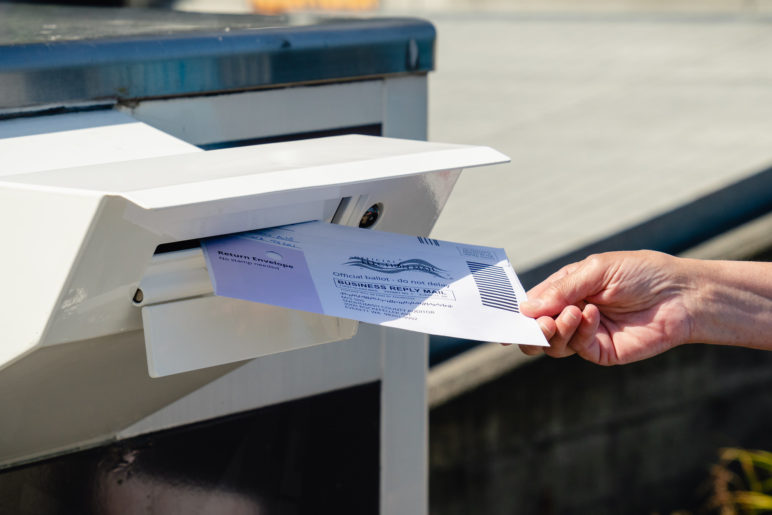
One of Cascadia’s major exports this year: voting by mail. Photo: Cindy Shebley, Creative Commons.
Here at Sightline, we see shoring up democracy as the best hope for protecting a human-habitable planet. When parties and elected officials must compete for popular approval and are able to pass laws people want, sustainability tends to win more often. This is the root of our support for election reforms like ranked-choice voting, voting by mail, and making the Electoral College obsolete.
Ranked-choice voting has seen mixed results. It passed by the slimmest of margins in Alaska, putting the 49th state on the vanguard of democracy reform. A statewide measure in Massachusetts failed by 10 points.
But cities had more success with local ranked-choice voting measures. In Minnesota, Minnetonka’s ranked-choice voting measure won with 55 percent support, while Bloomington’s measure with 51 percent. California cities saw an even wider lead: Eureka’s measure had 61 percent support, Albany’s 73 percent. Boulder, Colorado, overwhelmingly approved a measure to directly elect its mayor and use ranked-choice voting to do it, with 78 percent of voters in favor.
Colorado’s referendum for a national popular vote promises to put Colorado’s nine Electoral College votes behind the presidential candidate who wins the most votes nationwide. Voters approved the ballot measure with 52 percent support. The referendum allows Colorado to stay on the National Popular Vote Interstate Compact. (The compact would only take effect if enough states to elect a president were to join.)
Of course, the most influential choice voters are making about the future of democracy may have been at the top of their tickets. By waging a political war on vote-by-mail systems across the country through legal challenges, making it more difficult to cast ballots during the pandemic, urging Americans to distrust election results, and refusing to commit to a peaceful transition of power, President Donald Trump had made elections themselves a major subject of this election.
Americans, right and left, fear that democracy could be approaching a breaking point. On the bright side, it’s pushed Americans to take this election seriously and make their voices heard—it was shaping up to be the highest-turnout election in US history. That example might actually open a path to becoming a fairer, more representative government.













